Greenwood Residence: Water Supply, Treatment and Waste Management
VerifiedAdded on 2023/06/03
|9
|2137
|130
AI Summary
The article explores the water supply, treatment and waste management system of Greenwood Residence in Sydney, Australia. It covers topics such as rainwater harvesting, water treatment plants, waste management methods and more. The article also discusses the challenges affecting wastewater and the need for updating infrastructure. The type of energy used in the sustainable house is also mentioned.
Contribute Materials
Your contribution can guide someone’s learning journey. Share your
documents today.

Name of the Student
Name of the Professor
City/State
Date/Month/Year
Name of the Professor
City/State
Date/Month/Year
Secure Best Marks with AI Grader
Need help grading? Try our AI Grader for instant feedback on your assignments.
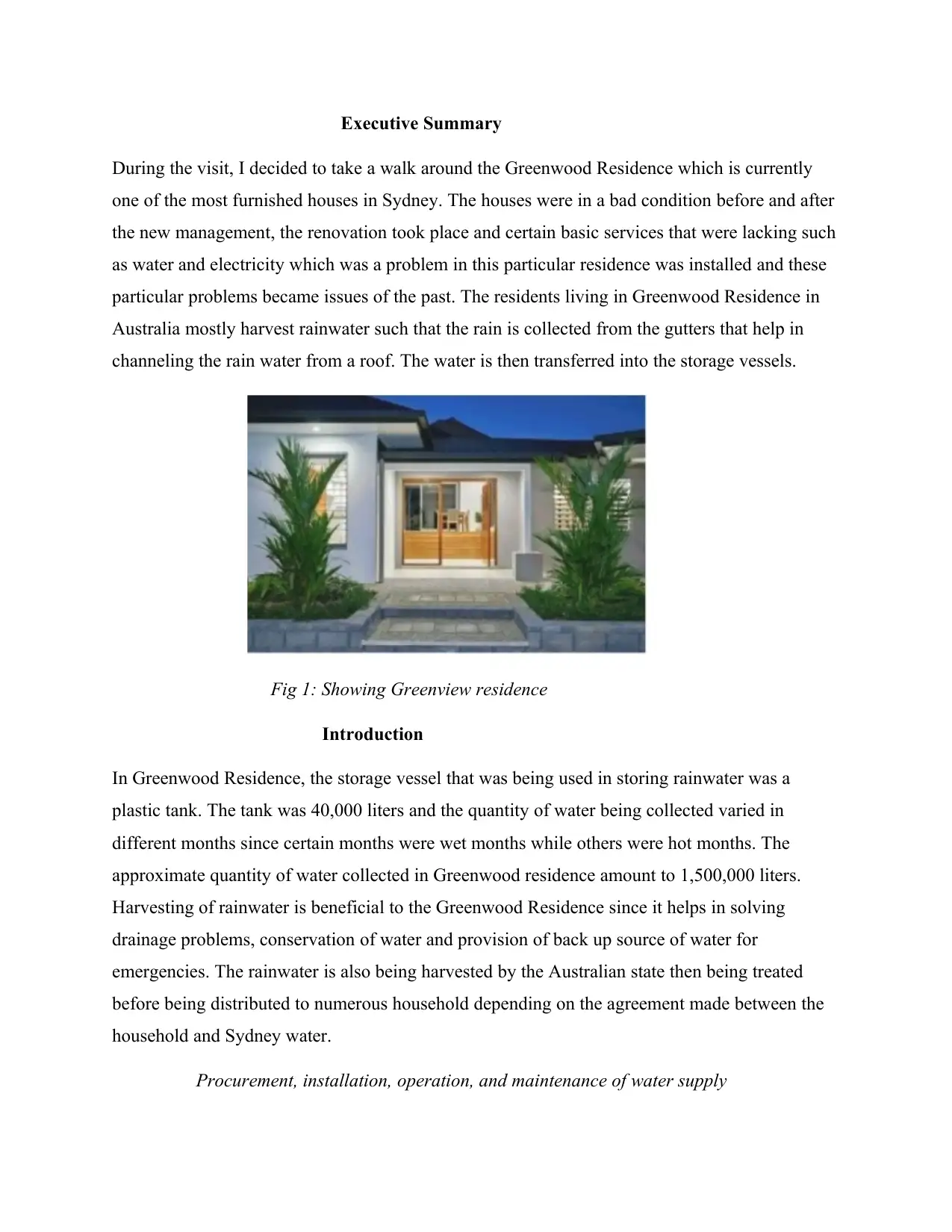
Executive Summary
During the visit, I decided to take a walk around the Greenwood Residence which is currently
one of the most furnished houses in Sydney. The houses were in a bad condition before and after
the new management, the renovation took place and certain basic services that were lacking such
as water and electricity which was a problem in this particular residence was installed and these
particular problems became issues of the past. The residents living in Greenwood Residence in
Australia mostly harvest rainwater such that the rain is collected from the gutters that help in
channeling the rain water from a roof. The water is then transferred into the storage vessels.
Fig 1: Showing Greenview residence
Introduction
In Greenwood Residence, the storage vessel that was being used in storing rainwater was a
plastic tank. The tank was 40,000 liters and the quantity of water being collected varied in
different months since certain months were wet months while others were hot months. The
approximate quantity of water collected in Greenwood residence amount to 1,500,000 liters.
Harvesting of rainwater is beneficial to the Greenwood Residence since it helps in solving
drainage problems, conservation of water and provision of back up source of water for
emergencies. The rainwater is also being harvested by the Australian state then being treated
before being distributed to numerous household depending on the agreement made between the
household and Sydney water.
Procurement, installation, operation, and maintenance of water supply
During the visit, I decided to take a walk around the Greenwood Residence which is currently
one of the most furnished houses in Sydney. The houses were in a bad condition before and after
the new management, the renovation took place and certain basic services that were lacking such
as water and electricity which was a problem in this particular residence was installed and these
particular problems became issues of the past. The residents living in Greenwood Residence in
Australia mostly harvest rainwater such that the rain is collected from the gutters that help in
channeling the rain water from a roof. The water is then transferred into the storage vessels.
Fig 1: Showing Greenview residence
Introduction
In Greenwood Residence, the storage vessel that was being used in storing rainwater was a
plastic tank. The tank was 40,000 liters and the quantity of water being collected varied in
different months since certain months were wet months while others were hot months. The
approximate quantity of water collected in Greenwood residence amount to 1,500,000 liters.
Harvesting of rainwater is beneficial to the Greenwood Residence since it helps in solving
drainage problems, conservation of water and provision of back up source of water for
emergencies. The rainwater is also being harvested by the Australian state then being treated
before being distributed to numerous household depending on the agreement made between the
household and Sydney water.
Procurement, installation, operation, and maintenance of water supply
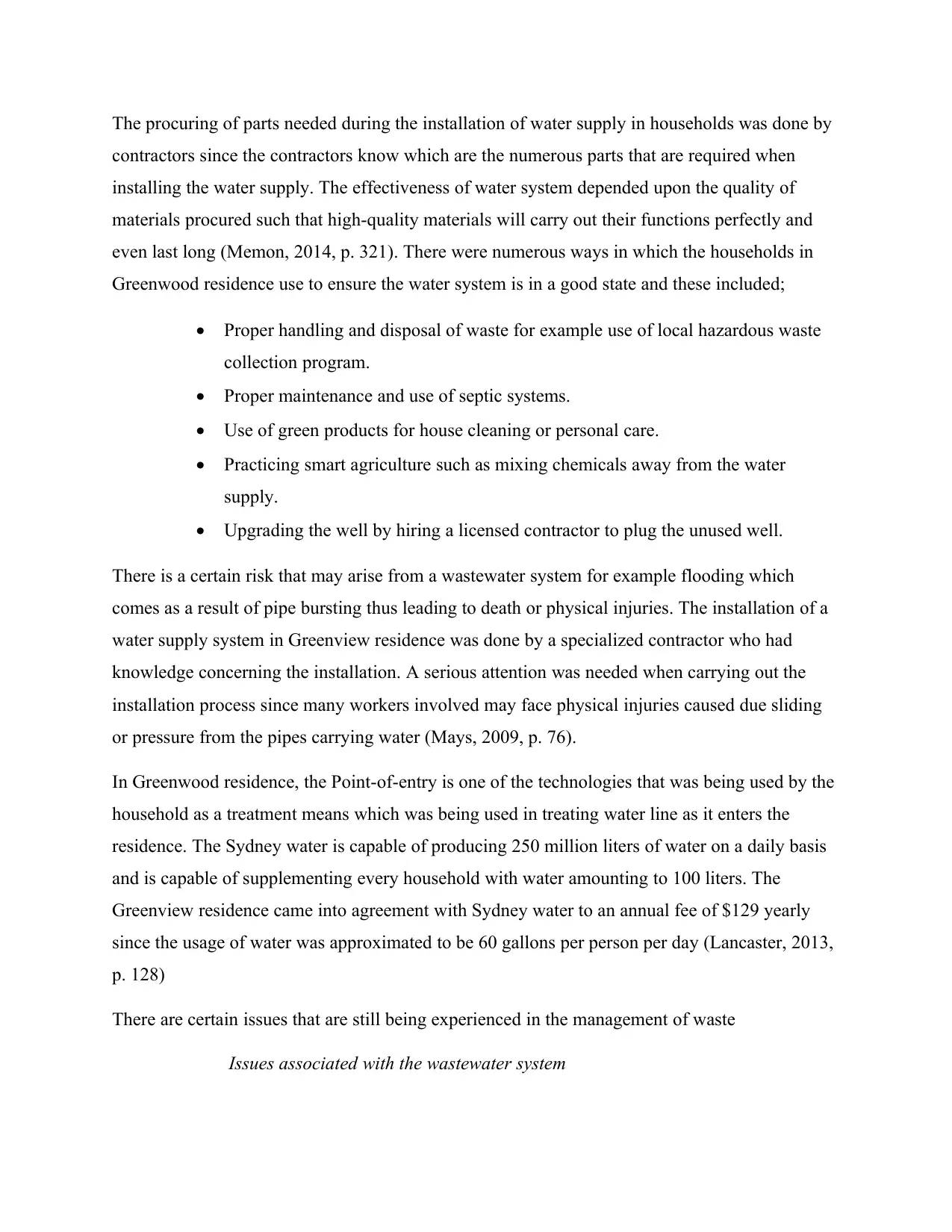
The procuring of parts needed during the installation of water supply in households was done by
contractors since the contractors know which are the numerous parts that are required when
installing the water supply. The effectiveness of water system depended upon the quality of
materials procured such that high-quality materials will carry out their functions perfectly and
even last long (Memon, 2014, p. 321). There were numerous ways in which the households in
Greenwood residence use to ensure the water system is in a good state and these included;
Proper handling and disposal of waste for example use of local hazardous waste
collection program.
Proper maintenance and use of septic systems.
Use of green products for house cleaning or personal care.
Practicing smart agriculture such as mixing chemicals away from the water
supply.
Upgrading the well by hiring a licensed contractor to plug the unused well.
There is a certain risk that may arise from a wastewater system for example flooding which
comes as a result of pipe bursting thus leading to death or physical injuries. The installation of a
water supply system in Greenview residence was done by a specialized contractor who had
knowledge concerning the installation. A serious attention was needed when carrying out the
installation process since many workers involved may face physical injuries caused due sliding
or pressure from the pipes carrying water (Mays, 2009, p. 76).
In Greenwood residence, the Point-of-entry is one of the technologies that was being used by the
household as a treatment means which was being used in treating water line as it enters the
residence. The Sydney water is capable of producing 250 million liters of water on a daily basis
and is capable of supplementing every household with water amounting to 100 liters. The
Greenview residence came into agreement with Sydney water to an annual fee of $129 yearly
since the usage of water was approximated to be 60 gallons per person per day (Lancaster, 2013,
p. 128)
There are certain issues that are still being experienced in the management of waste
Issues associated with the wastewater system
contractors since the contractors know which are the numerous parts that are required when
installing the water supply. The effectiveness of water system depended upon the quality of
materials procured such that high-quality materials will carry out their functions perfectly and
even last long (Memon, 2014, p. 321). There were numerous ways in which the households in
Greenwood residence use to ensure the water system is in a good state and these included;
Proper handling and disposal of waste for example use of local hazardous waste
collection program.
Proper maintenance and use of septic systems.
Use of green products for house cleaning or personal care.
Practicing smart agriculture such as mixing chemicals away from the water
supply.
Upgrading the well by hiring a licensed contractor to plug the unused well.
There is a certain risk that may arise from a wastewater system for example flooding which
comes as a result of pipe bursting thus leading to death or physical injuries. The installation of a
water supply system in Greenview residence was done by a specialized contractor who had
knowledge concerning the installation. A serious attention was needed when carrying out the
installation process since many workers involved may face physical injuries caused due sliding
or pressure from the pipes carrying water (Mays, 2009, p. 76).
In Greenwood residence, the Point-of-entry is one of the technologies that was being used by the
household as a treatment means which was being used in treating water line as it enters the
residence. The Sydney water is capable of producing 250 million liters of water on a daily basis
and is capable of supplementing every household with water amounting to 100 liters. The
Greenview residence came into agreement with Sydney water to an annual fee of $129 yearly
since the usage of water was approximated to be 60 gallons per person per day (Lancaster, 2013,
p. 128)
There are certain issues that are still being experienced in the management of waste
Issues associated with the wastewater system
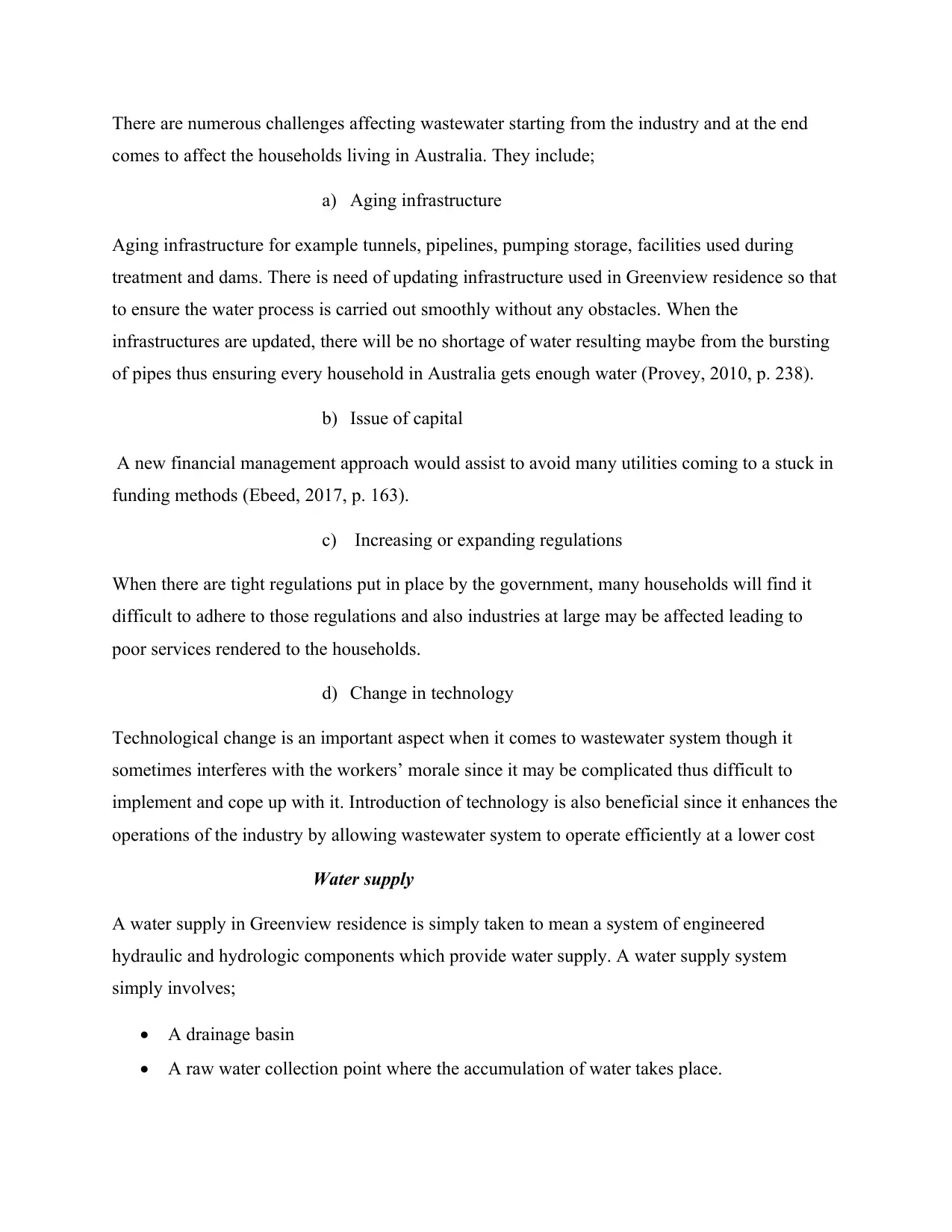
There are numerous challenges affecting wastewater starting from the industry and at the end
comes to affect the households living in Australia. They include;
a) Aging infrastructure
Aging infrastructure for example tunnels, pipelines, pumping storage, facilities used during
treatment and dams. There is need of updating infrastructure used in Greenview residence so that
to ensure the water process is carried out smoothly without any obstacles. When the
infrastructures are updated, there will be no shortage of water resulting maybe from the bursting
of pipes thus ensuring every household in Australia gets enough water (Provey, 2010, p. 238).
b) Issue of capital
A new financial management approach would assist to avoid many utilities coming to a stuck in
funding methods (Ebeed, 2017, p. 163).
c) Increasing or expanding regulations
When there are tight regulations put in place by the government, many households will find it
difficult to adhere to those regulations and also industries at large may be affected leading to
poor services rendered to the households.
d) Change in technology
Technological change is an important aspect when it comes to wastewater system though it
sometimes interferes with the workers’ morale since it may be complicated thus difficult to
implement and cope up with it. Introduction of technology is also beneficial since it enhances the
operations of the industry by allowing wastewater system to operate efficiently at a lower cost
Water supply
A water supply in Greenview residence is simply taken to mean a system of engineered
hydraulic and hydrologic components which provide water supply. A water supply system
simply involves;
A drainage basin
A raw water collection point where the accumulation of water takes place.
comes to affect the households living in Australia. They include;
a) Aging infrastructure
Aging infrastructure for example tunnels, pipelines, pumping storage, facilities used during
treatment and dams. There is need of updating infrastructure used in Greenview residence so that
to ensure the water process is carried out smoothly without any obstacles. When the
infrastructures are updated, there will be no shortage of water resulting maybe from the bursting
of pipes thus ensuring every household in Australia gets enough water (Provey, 2010, p. 238).
b) Issue of capital
A new financial management approach would assist to avoid many utilities coming to a stuck in
funding methods (Ebeed, 2017, p. 163).
c) Increasing or expanding regulations
When there are tight regulations put in place by the government, many households will find it
difficult to adhere to those regulations and also industries at large may be affected leading to
poor services rendered to the households.
d) Change in technology
Technological change is an important aspect when it comes to wastewater system though it
sometimes interferes with the workers’ morale since it may be complicated thus difficult to
implement and cope up with it. Introduction of technology is also beneficial since it enhances the
operations of the industry by allowing wastewater system to operate efficiently at a lower cost
Water supply
A water supply in Greenview residence is simply taken to mean a system of engineered
hydraulic and hydrologic components which provide water supply. A water supply system
simply involves;
A drainage basin
A raw water collection point where the accumulation of water takes place.
Secure Best Marks with AI Grader
Need help grading? Try our AI Grader for instant feedback on your assignments.
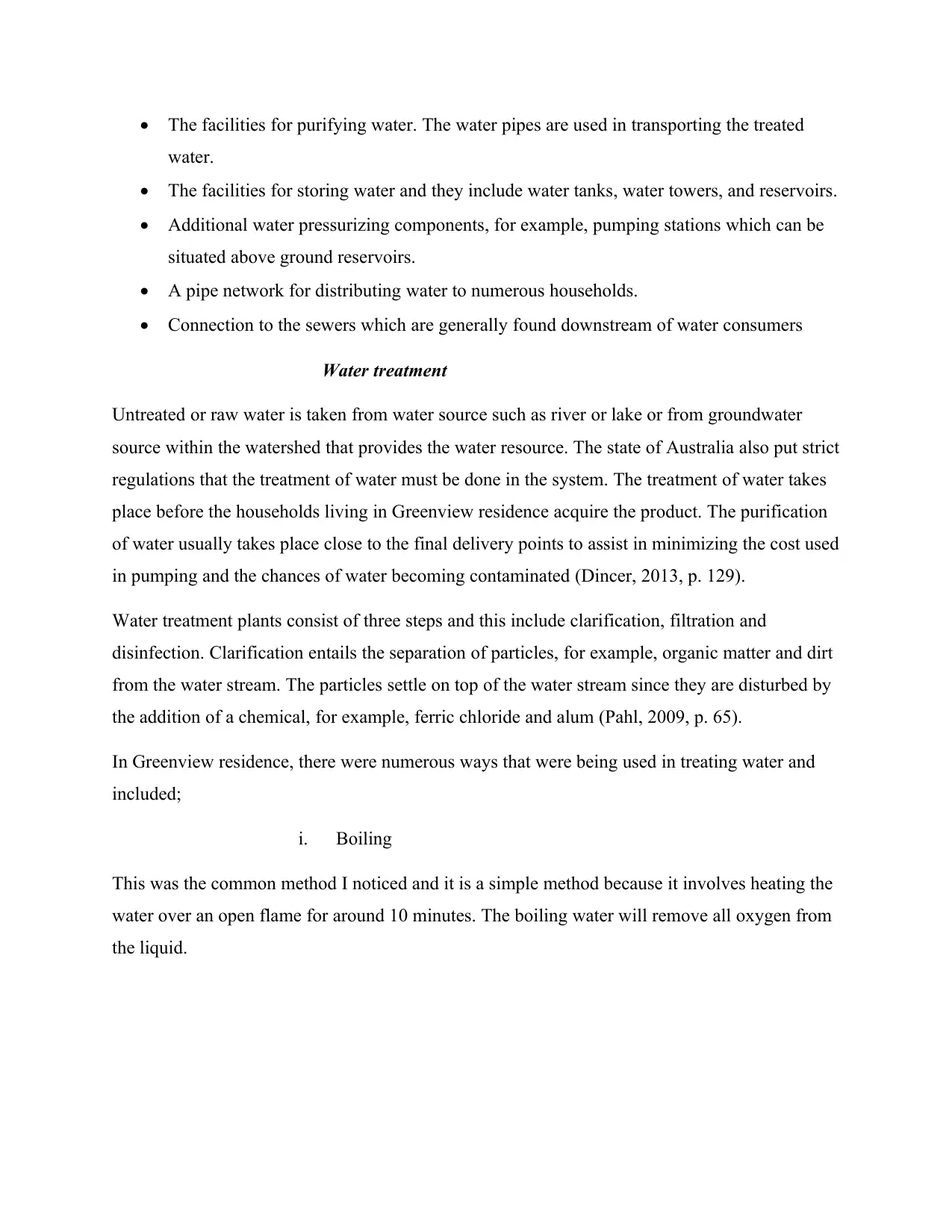
The facilities for purifying water. The water pipes are used in transporting the treated
water.
The facilities for storing water and they include water tanks, water towers, and reservoirs.
Additional water pressurizing components, for example, pumping stations which can be
situated above ground reservoirs.
A pipe network for distributing water to numerous households.
Connection to the sewers which are generally found downstream of water consumers
Water treatment
Untreated or raw water is taken from water source such as river or lake or from groundwater
source within the watershed that provides the water resource. The state of Australia also put strict
regulations that the treatment of water must be done in the system. The treatment of water takes
place before the households living in Greenview residence acquire the product. The purification
of water usually takes place close to the final delivery points to assist in minimizing the cost used
in pumping and the chances of water becoming contaminated (Dincer, 2013, p. 129).
Water treatment plants consist of three steps and this include clarification, filtration and
disinfection. Clarification entails the separation of particles, for example, organic matter and dirt
from the water stream. The particles settle on top of the water stream since they are disturbed by
the addition of a chemical, for example, ferric chloride and alum (Pahl, 2009, p. 65).
In Greenview residence, there were numerous ways that were being used in treating water and
included;
i. Boiling
This was the common method I noticed and it is a simple method because it involves heating the
water over an open flame for around 10 minutes. The boiling water will remove all oxygen from
the liquid.
water.
The facilities for storing water and they include water tanks, water towers, and reservoirs.
Additional water pressurizing components, for example, pumping stations which can be
situated above ground reservoirs.
A pipe network for distributing water to numerous households.
Connection to the sewers which are generally found downstream of water consumers
Water treatment
Untreated or raw water is taken from water source such as river or lake or from groundwater
source within the watershed that provides the water resource. The state of Australia also put strict
regulations that the treatment of water must be done in the system. The treatment of water takes
place before the households living in Greenview residence acquire the product. The purification
of water usually takes place close to the final delivery points to assist in minimizing the cost used
in pumping and the chances of water becoming contaminated (Dincer, 2013, p. 129).
Water treatment plants consist of three steps and this include clarification, filtration and
disinfection. Clarification entails the separation of particles, for example, organic matter and dirt
from the water stream. The particles settle on top of the water stream since they are disturbed by
the addition of a chemical, for example, ferric chloride and alum (Pahl, 2009, p. 65).
In Greenview residence, there were numerous ways that were being used in treating water and
included;
i. Boiling
This was the common method I noticed and it is a simple method because it involves heating the
water over an open flame for around 10 minutes. The boiling water will remove all oxygen from
the liquid.
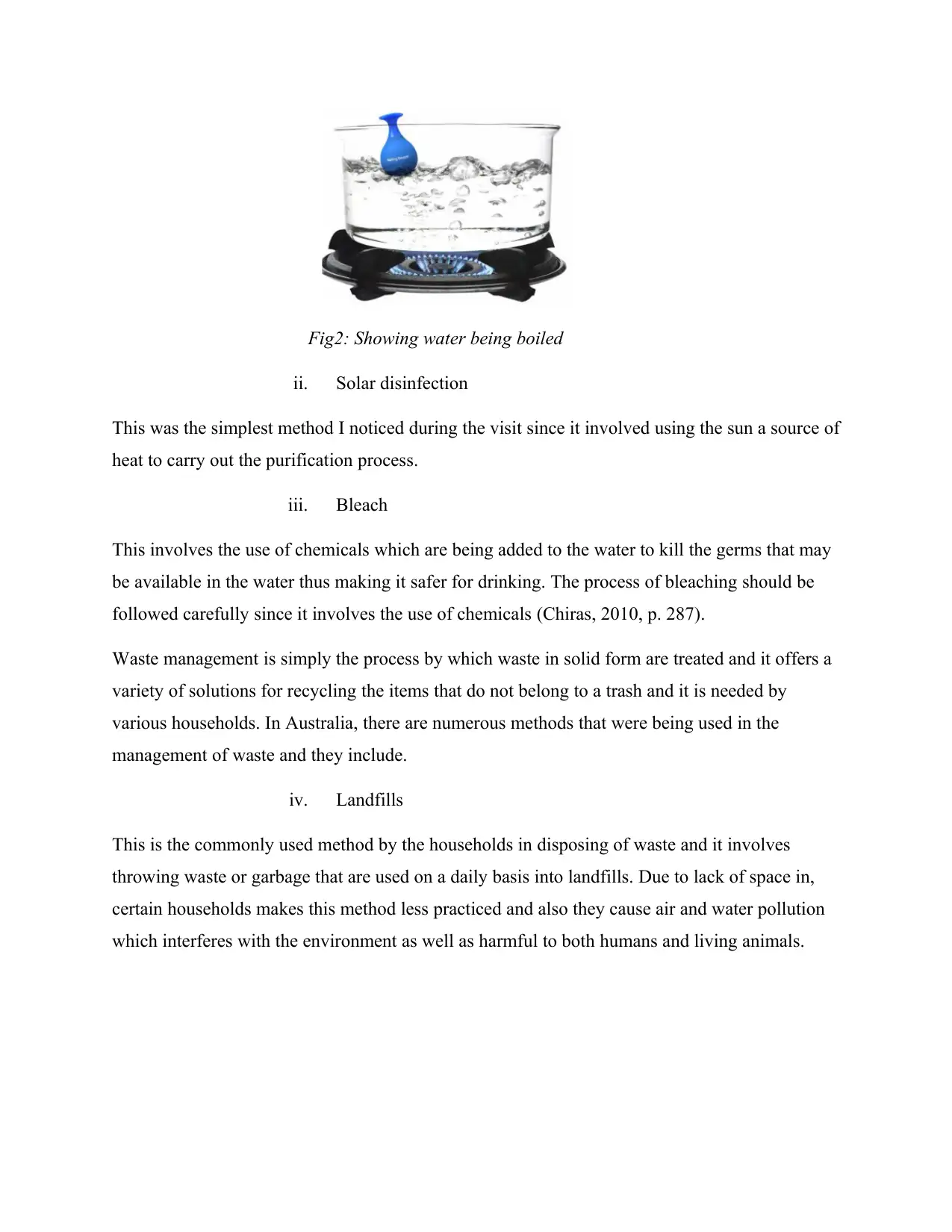
Fig2: Showing water being boiled
ii. Solar disinfection
This was the simplest method I noticed during the visit since it involved using the sun a source of
heat to carry out the purification process.
iii. Bleach
This involves the use of chemicals which are being added to the water to kill the germs that may
be available in the water thus making it safer for drinking. The process of bleaching should be
followed carefully since it involves the use of chemicals (Chiras, 2010, p. 287).
Waste management is simply the process by which waste in solid form are treated and it offers a
variety of solutions for recycling the items that do not belong to a trash and it is needed by
various households. In Australia, there are numerous methods that were being used in the
management of waste and they include.
iv. Landfills
This is the commonly used method by the households in disposing of waste and it involves
throwing waste or garbage that are used on a daily basis into landfills. Due to lack of space in,
certain households makes this method less practiced and also they cause air and water pollution
which interferes with the environment as well as harmful to both humans and living animals.
ii. Solar disinfection
This was the simplest method I noticed during the visit since it involved using the sun a source of
heat to carry out the purification process.
iii. Bleach
This involves the use of chemicals which are being added to the water to kill the germs that may
be available in the water thus making it safer for drinking. The process of bleaching should be
followed carefully since it involves the use of chemicals (Chiras, 2010, p. 287).
Waste management is simply the process by which waste in solid form are treated and it offers a
variety of solutions for recycling the items that do not belong to a trash and it is needed by
various households. In Australia, there are numerous methods that were being used in the
management of waste and they include.
iv. Landfills
This is the commonly used method by the households in disposing of waste and it involves
throwing waste or garbage that are used on a daily basis into landfills. Due to lack of space in,
certain households makes this method less practiced and also they cause air and water pollution
which interferes with the environment as well as harmful to both humans and living animals.
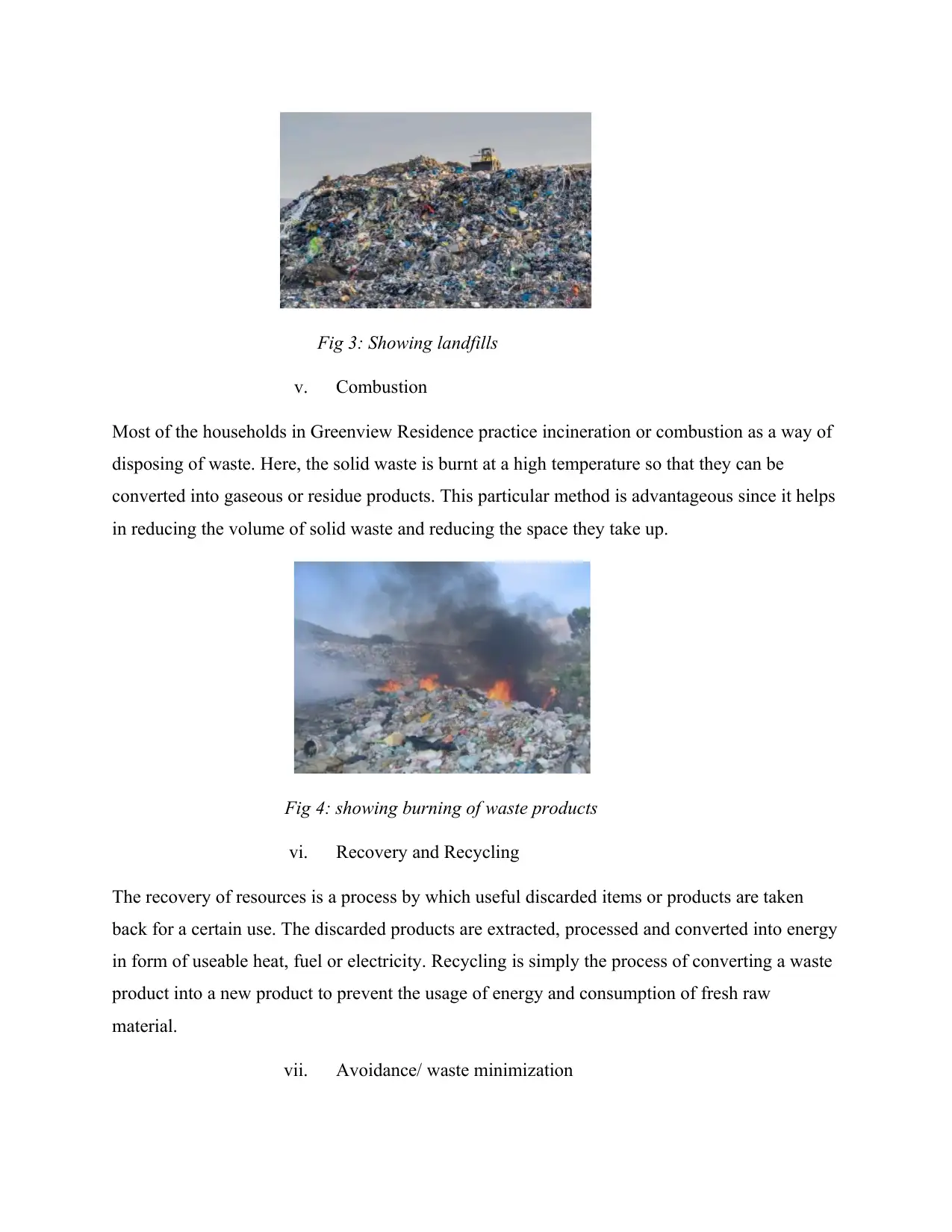
Fig 3: Showing landfills
v. Combustion
Most of the households in Greenview Residence practice incineration or combustion as a way of
disposing of waste. Here, the solid waste is burnt at a high temperature so that they can be
converted into gaseous or residue products. This particular method is advantageous since it helps
in reducing the volume of solid waste and reducing the space they take up.
Fig 4: showing burning of waste products
vi. Recovery and Recycling
The recovery of resources is a process by which useful discarded items or products are taken
back for a certain use. The discarded products are extracted, processed and converted into energy
in form of useable heat, fuel or electricity. Recycling is simply the process of converting a waste
product into a new product to prevent the usage of energy and consumption of fresh raw
material.
vii. Avoidance/ waste minimization
v. Combustion
Most of the households in Greenview Residence practice incineration or combustion as a way of
disposing of waste. Here, the solid waste is burnt at a high temperature so that they can be
converted into gaseous or residue products. This particular method is advantageous since it helps
in reducing the volume of solid waste and reducing the space they take up.
Fig 4: showing burning of waste products
vi. Recovery and Recycling
The recovery of resources is a process by which useful discarded items or products are taken
back for a certain use. The discarded products are extracted, processed and converted into energy
in form of useable heat, fuel or electricity. Recycling is simply the process of converting a waste
product into a new product to prevent the usage of energy and consumption of fresh raw
material.
vii. Avoidance/ waste minimization
Paraphrase This Document
Need a fresh take? Get an instant paraphrase of this document with our AI Paraphraser
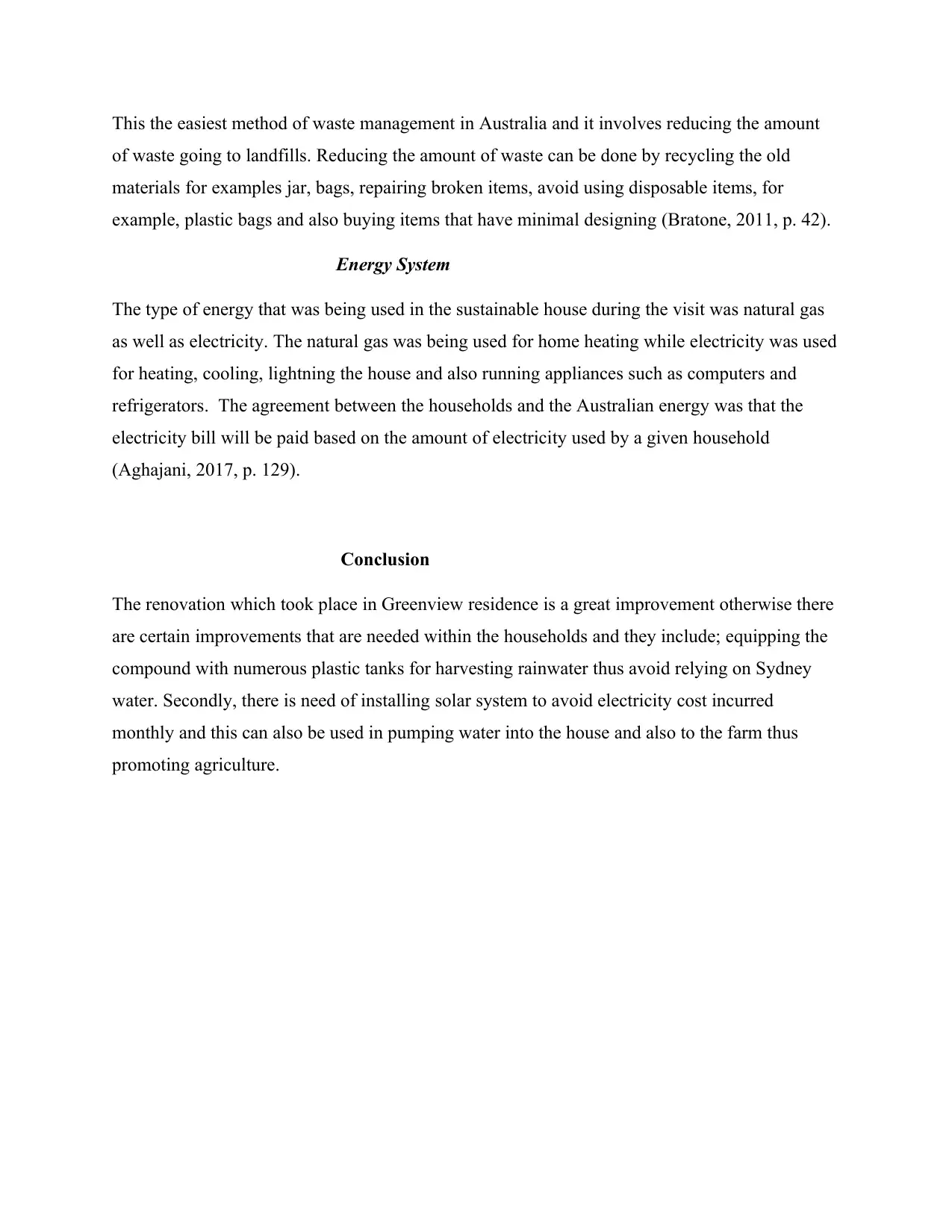
This the easiest method of waste management in Australia and it involves reducing the amount
of waste going to landfills. Reducing the amount of waste can be done by recycling the old
materials for examples jar, bags, repairing broken items, avoid using disposable items, for
example, plastic bags and also buying items that have minimal designing (Bratone, 2011, p. 42).
Energy System
The type of energy that was being used in the sustainable house during the visit was natural gas
as well as electricity. The natural gas was being used for home heating while electricity was used
for heating, cooling, lightning the house and also running appliances such as computers and
refrigerators. The agreement between the households and the Australian energy was that the
electricity bill will be paid based on the amount of electricity used by a given household
(Aghajani, 2017, p. 129).
Conclusion
The renovation which took place in Greenview residence is a great improvement otherwise there
are certain improvements that are needed within the households and they include; equipping the
compound with numerous plastic tanks for harvesting rainwater thus avoid relying on Sydney
water. Secondly, there is need of installing solar system to avoid electricity cost incurred
monthly and this can also be used in pumping water into the house and also to the farm thus
promoting agriculture.
of waste going to landfills. Reducing the amount of waste can be done by recycling the old
materials for examples jar, bags, repairing broken items, avoid using disposable items, for
example, plastic bags and also buying items that have minimal designing (Bratone, 2011, p. 42).
Energy System
The type of energy that was being used in the sustainable house during the visit was natural gas
as well as electricity. The natural gas was being used for home heating while electricity was used
for heating, cooling, lightning the house and also running appliances such as computers and
refrigerators. The agreement between the households and the Australian energy was that the
electricity bill will be paid based on the amount of electricity used by a given household
(Aghajani, 2017, p. 129).
Conclusion
The renovation which took place in Greenview residence is a great improvement otherwise there
are certain improvements that are needed within the households and they include; equipping the
compound with numerous plastic tanks for harvesting rainwater thus avoid relying on Sydney
water. Secondly, there is need of installing solar system to avoid electricity cost incurred
monthly and this can also be used in pumping water into the house and also to the farm thus
promoting agriculture.

Bibliography
Aghajani, M., 2017.
University campus solid waste management. s.l. OLMA Media group.
Bratone, C., 2011.
Investment in solid waste management. s.l. Carlton Books.
Chang, N.-B., 2015.
Sustainable solid waste management. s.l. Adventure Works Press.
Chiras, D., 2010.
Solae electricity basics. s.l. Scholastic.
Dincer, I., 2013.
Advanced power generation system. s.l.: Random House.
Ebeed, A., 2017.
Backyard wind turbines. s.l.:Informa.
Lancaster, B., 2013.
Rainwater harvesting for drylands and beyond. s.l.: Reed Elsevier.
Mays, L., 2009.
Water supply systems security. s.l.: Pearson.
Memon, F., 2014.
Alternative water supply system. s.l.: Wolters Kluwer.
Olivier, P., 2011.
The integrated waste management system. s.l. Blake publishing.
Pacey, A., 2016.
Rainwater harvesting. s.l. Media Participation.
Pahl, G., 2009.
The citizen-powered energy handbook. s.l.: Thomson Reuters.
Povey, J., 2010.
Convert your home to solar energy. s.l.: Hachette Livre.
Shea, K., 2011.
Build your own small wind power systems. s.l. Casemate Publishers.
Aghajani, M., 2017.
University campus solid waste management. s.l. OLMA Media group.
Bratone, C., 2011.
Investment in solid waste management. s.l. Carlton Books.
Chang, N.-B., 2015.
Sustainable solid waste management. s.l. Adventure Works Press.
Chiras, D., 2010.
Solae electricity basics. s.l. Scholastic.
Dincer, I., 2013.
Advanced power generation system. s.l.: Random House.
Ebeed, A., 2017.
Backyard wind turbines. s.l.:Informa.
Lancaster, B., 2013.
Rainwater harvesting for drylands and beyond. s.l.: Reed Elsevier.
Mays, L., 2009.
Water supply systems security. s.l.: Pearson.
Memon, F., 2014.
Alternative water supply system. s.l.: Wolters Kluwer.
Olivier, P., 2011.
The integrated waste management system. s.l. Blake publishing.
Pacey, A., 2016.
Rainwater harvesting. s.l. Media Participation.
Pahl, G., 2009.
The citizen-powered energy handbook. s.l.: Thomson Reuters.
Povey, J., 2010.
Convert your home to solar energy. s.l.: Hachette Livre.
Shea, K., 2011.
Build your own small wind power systems. s.l. Casemate Publishers.
1 out of 9
Your All-in-One AI-Powered Toolkit for Academic Success.
+13062052269
info@desklib.com
Available 24*7 on WhatsApp / Email
![[object Object]](/_next/static/media/star-bottom.7253800d.svg)
Unlock your academic potential
© 2024 | Zucol Services PVT LTD | All rights reserved.

